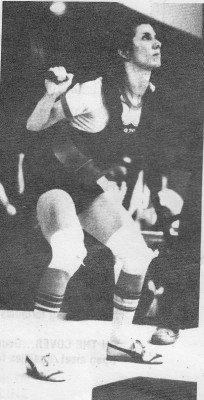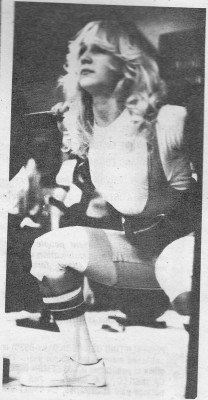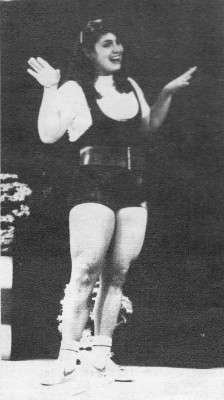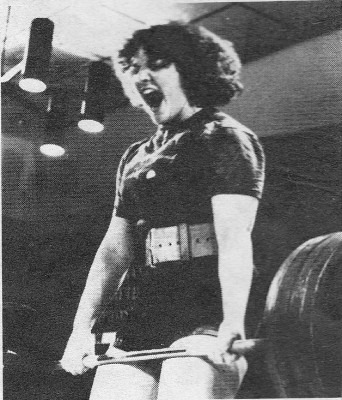I asked the 70’s Big Facebook Fan Page folks to ask some questions for a podcast (the thread started on June 2). This is a solo podcast I did answering both good and horrible questions. Enjoy.
LINK(right click and “save target as”)
46:16 long. iTunes feed is all ganked up, but I’m working on it.
Oh, and Happy PR Friday. Training updates, PR’s, whatever. I don’t really care. Oh, and this post needs a random picture:

Marvin Eder
The Tight Tan Slacks of Dezbo Ban is a fantastic website that is full of legendary stories and articles from over half a century ago. THIS article on Marvin Eder is very interesting several reasons.

Mark Eder and the Canadian Colossus Doug Hepburn were having a legit face off, a showing of strength on muscle beach. THIS WAS FOR ALL THE MARBLES
The action heated up when the bar reached 420. Juliano dropped out, but that was no disgrace for a 17-year old superman. Eder, not much older at 19, blasted out two reps with 420. Hepburn also rammed up the 420. Eder then did 430 pounds in strict style – thereby setting a new, albeit unofficial, world record. Hepburn lifted the same poundage and announced the fact that he was just warming up. he then benched 440, but his form was so rough Marvin said, “Nice lift, Doug. You must have lost two inches off your chest the way the bar bounced off your pecs.” Everybody in the large crowd surrounding the workout area laughed. Except Doug.
I bet Doug was pissed, but did he start a fight? Did he break a bottle over his head and try and stab Eder with the pieces?
Hepburn, who set a world record in the military press at the National Weightlifting Championships a few days later, went into his strongman prop bag and brought out a thick leather belt, with which he strapped two 45-pound plates together. He lifted the plates overhead with his left hand, then lowered them until his arm was parallel to the ground. It was known as the one-arm holdout. He held the weights in the muscled-out position for five seconds. The crowd gasped and applauded. They went wild when Eder duplicated the feat – and held the plates out for 10 seconds.
Ah, the strong men of lore. So impressive — yet Eder is obnoxiously impressive. Read the article, because I won’t be able to cover it all.
Muscle photographer Art Zeller remembered seeing Marvin Eder hold his arms out while a 150-pound hand-balancer named Maurice Maruitz put his hands on Eder’s wrists s though they were parallel bars, leapt up, and went into a handstand. “Eder just stood there like a rock, without quivering at all. He looked like he could have stood there all day,” Zeller said.
As for his top end strength:
Eder’s feats of strength include a 515-pound bench press, squatting 550-pounds for 10 deep reps, 12 one-arm chins and a 365-pound overhead press. At the 1951 Pan-American Games tryouts, he surpassed the world record in the press with 337 at a bodyweight of 192, but the AAU refused to let him compete.
And lastly, as a 67 year old (in 1999), Eder was still training and looking solid:
Today (1999), at age 67, Marvin can still do 100 dips anytime, and more amazing, 90 chinups. I saw him last year at the Oldetime Barbell & Strongmen’s annual dinner. H told me that his three-times-a-week workout consists of five sets of chins for 50 reps, five sets of dips for 50 reps and 550 alternate jumping lunge squats. He still weighs 197 pounds and looks sensational.
That’s so awesome. Eder is now one of my strength idols.
The ZJ
So it’s $10 for a BJ, $12 for an HJ, $15 for a ZJ…
What’s a ZJ?
If you have to ask, big man, you can’t afford it.
This concept popped into my head last night when I was brushing my teeth. Antigen and I were talking about a lifting contest we will host here on the site, and I thought about ego lifters.
Ego lifters are folks who a) are under the impression that everyone else in the gym gives a shit about what they are doing, b) think it’s a good idea to do one more set or make one more jump in weight, or c) unintelligibly make a huge jump in weight typically followed by a complete failure.
Coaching, by definition, shouldn’t be ego driven. Coaches want the most out of their lifters, especially in competition, but knowing when to challenge their lifter is important. For example, let’s say I have the squat attempts planned out for “Timmy” in his fourth power meet. I will usually have a “best case scenario” and “not as good case scenario” attempts written out. Let’s say Timmy hits his second squat at 502, and we wanted to go to 524. Well, if that 502 was harder than it should be (because he had to cut weight, because of a bad taper, because he didn’t sleep — any random reason), I might say, “All right, Timmy, do you want to go to 513 or 524?” knowing that I may choose 513 and not the original 524 since 502 was a grinder. If he hesitates in his answer, then I already know my answer: 513. If he says “524” right off the bat, then I know he has confidence that he can get it. In this case, confidence and adrenaline may summon the demons to hit that 524, but if Timmy isn’t confident in it when asked, then it most likely isn’t gonna happen.
If a lifter has to ask himself, “Can I make this jump?” or “Should I get one more set?”, then he probably can’t afford it. When training, I advise you to think about what the goal is for the day. Are you trying to get some accumulated volume? Then three sets of five is probably enough, especially if the third set was kinda tough. Are you trying to keep the volume down? Then don’t do another set if you’ve done a 3×5. If you were keeping the volume down and trying to get some intensity, it’s relative. If you hit your minimum goal of, say, 425 for a double after doing 405 and 415 for doubles, then a fourth double will be superfluous.
If you have to ask, big man, you can’t afford it.
Pull-up Challenge
ExtremePullups.com is having an internet pull-up challenge to see who can do the most pull-ups with a 45 pound plate (see rules here).
My buddy Antigen is participating in this event. In the following video, he does 21 reps at a body weight of 181.
Pretty damn impressive. Pull-up strength is something that I’ve been working on this year and I definitely see the utility in its carry over into other lifts like bench press and press. Weighted pull-ups also help build musculature in the lats, rear shoulder girdle, biceps, and forearms. They can be done once a week, or twice a week with the second session done with chin-ups (supinated grip). Typically you’ll be stronger with pull-ups than chin-ups, although when you start this may not be the case (it wasn’t when I started). Place pull-ups/chin-ups after other larger exercises. They can be done as the primary back work for the day, or after other exercises that stress the back (for example, I regularly do chin-ups after deadlifting on Friday).
There are some various ways to train them. Here is a quick synopsis:
1. A simple 3×5 progression over time. I usually recommend this at first, especially if there isn’t a lot of weight being added.
2. Once the 3×5 gets to the 50 pound mark, then one option is to drop and go for max reps with 25 pounds, and then go for max reps with body weight. I’ve hit 21 body weight pull-ups after several heavy sets of weighted work.
3. Saul told me this next tidbit, and he got it from Bill Starr. You would rotate through these every week.
a) 8RM
b) 5RM + -50lb rep out
c) 3RM + -50lb rep out
As you see, after the 5 and 3RM, you would drop 50 pounds and rep out at that weight.
4. This last portion is what Saul used to train his “45 lbs for reps” set. He simply did 3 sets of as many reps as he could with a 45lb plate. On the chin-up day, he rotated the options in #3.
These are four methods you can use in weighted pull-up programming with the first two progressions aimed at a beginner. Oh, one more thing: it helps if you do them in a tank-top.
Women in Powerlifting
We don’t really get an opportunity to talk about historic women on 70’s Big, so I’d like to highlight some women lifters from the 1981 Women’s National Powerlifting Championships. You’ll see that these women were not only strong, but pretty good lookin’ too. All the numbers from this meet are in kilograms. All of the following women won their respective weight classes. And “(WR)” denotes a world record.

Terry Dillard
Terry Dillard squatted 137.5 (WR), benched 57.5, and deadlifted 145 for a 340 (WR) total. That’s a 302.5 pound squat for a 105.6 pound woman. She also won Best Lifter.

Gayla Crain
Gayla Crain, a 56 kg lifter, squatted 152.5, benched 70, and deadlifted 180 for a 402.5 (WR) total. Great hair. She’s my favorite of this bunch.

Vicky Gagne
Vicky Gagne competed in the 82.5 kilo class. She squatted 202.5 (WR), benched 115, and deadlifted 220 (WR) for a 537.5 total! That is a 445.5 pound squat and a 484 pound deadlift. In the picture, she had been red lighted on a 507 lb. deadlifted, and said, “It’s ok, I’ll get it next time.” Kinda cute.

Wanda Sander
Wanda Sander won the 82.5+ kg class with a 192.5 kg squat, 110 kg bench, and a 210 kg deadlift. Damn strong.
Who are your favorite female athletes?

